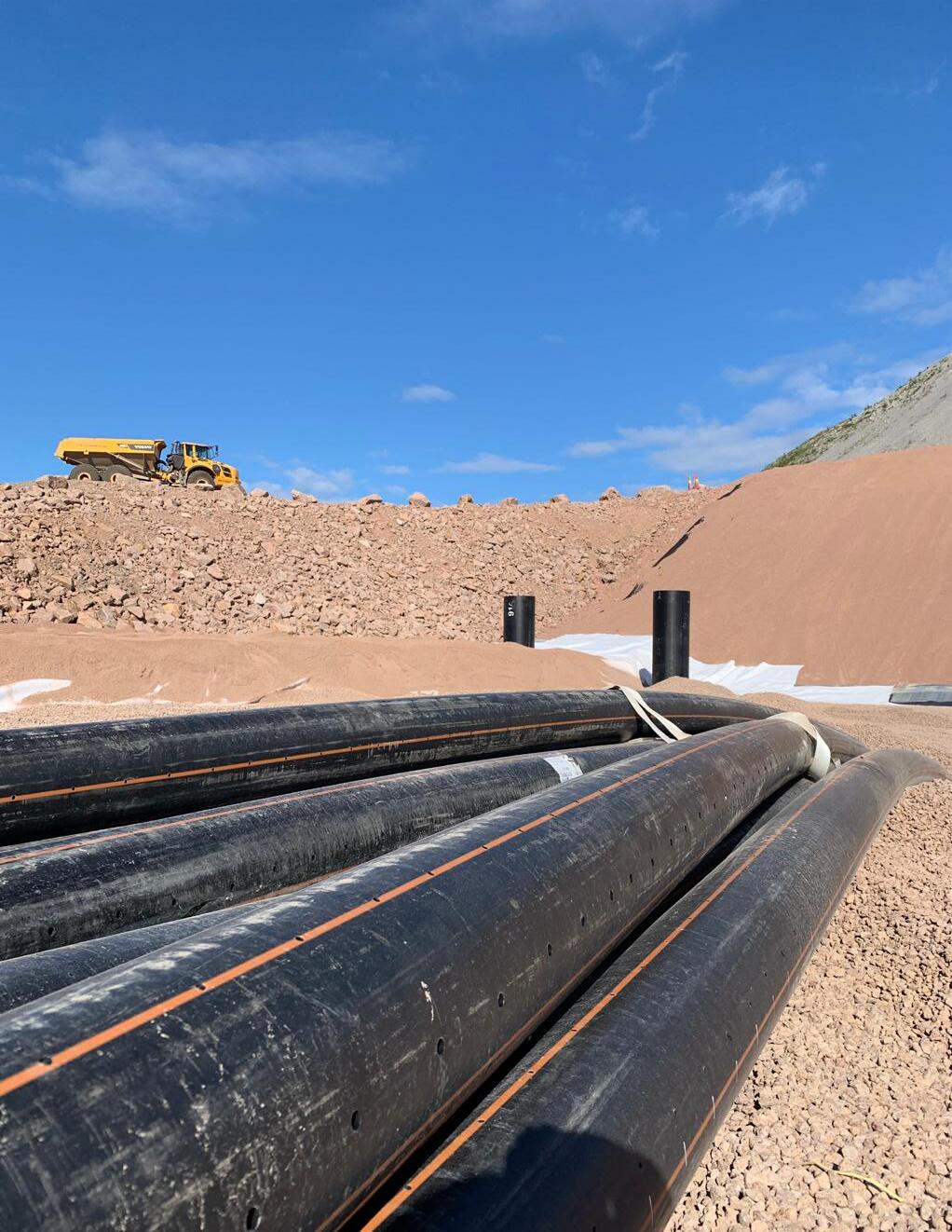

ANNUAL
2022
REPORT
Annual Report 2022
earthresQue Report no. 7
ISBN: 978-82-575-2982-6
RCN project 310042
Illustration front cover and end page: earthresQue
Photos by earthresQue unless otherwise stated
Photo front cover: Showfabrikken/Kystverket
Photo colofon spread: Pexels
Publisher: NMBU – Norwegian University of Life Sciences
earthresQue, Rescue of earth materials and wastes in the circular economy, Centre for Research-based Innovation
www.earthresQue.no
www.earthresQue.com
earthresQue.no
earthresQue.com
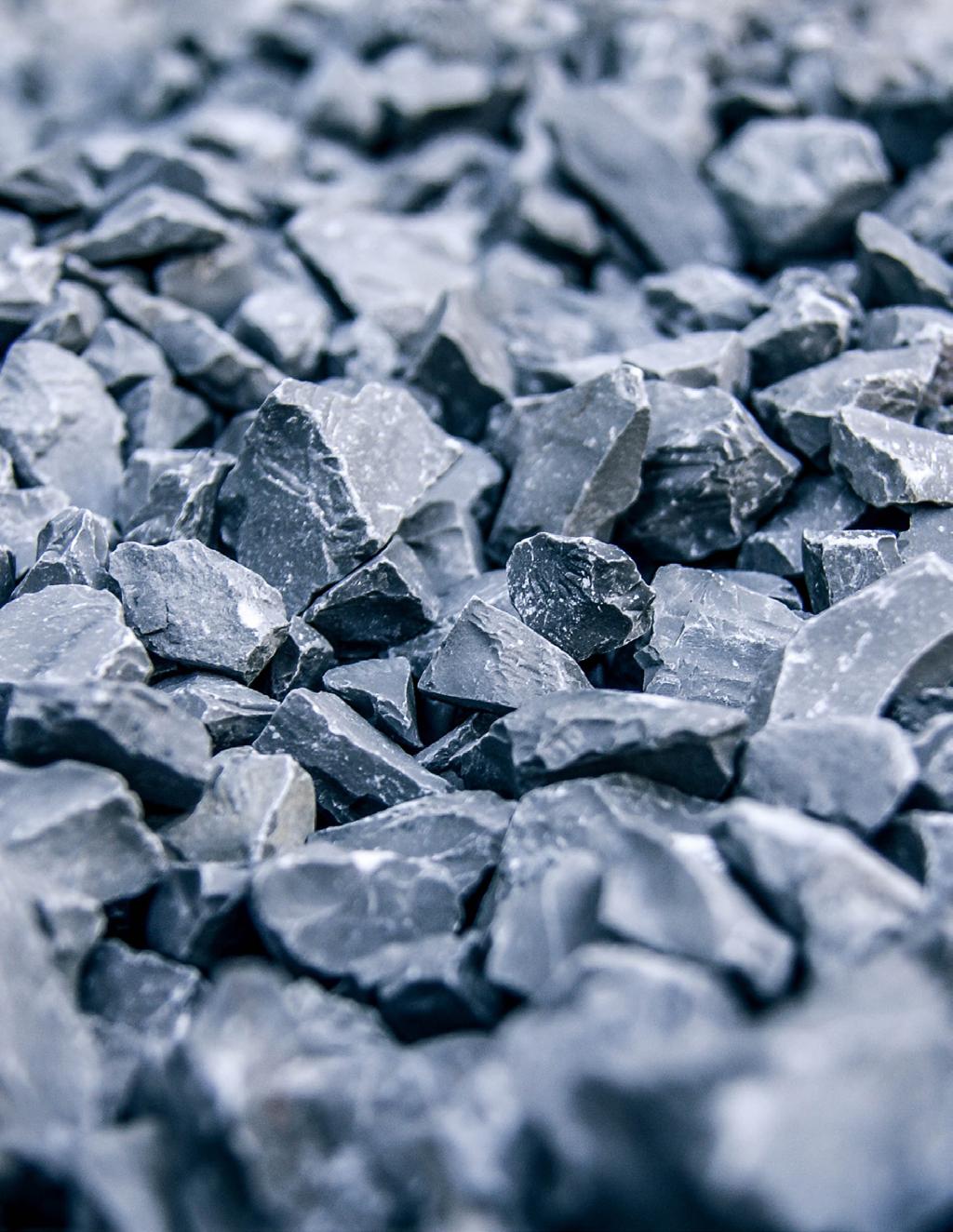
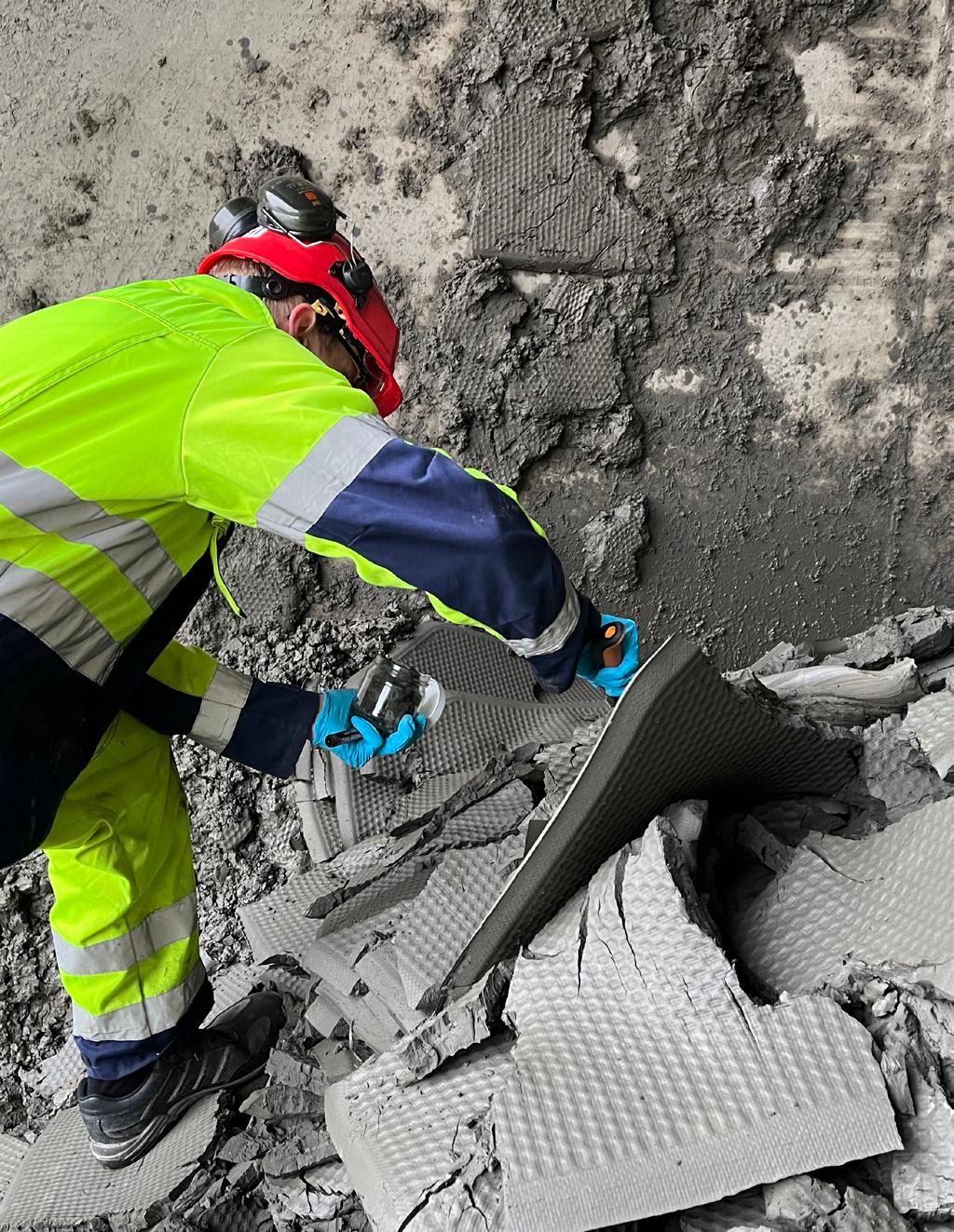
Content 06 Summary 09 Vision and objectives 10 Research plan and strategy 12 Work with innovation in earthresQue 14 Organisation 18 Scientific activities and results 31 International cooperation 33 Recruitment 34 Communication and dissemination highlights 37 Annual account 2022
Summary
2022 has been an active year for earthresQue. Research activities, both on site and in laboratories have been started. The number of students to take master’s and PhD in earthresQue is increasing. We are creating stronger links among collaborating partners and between students in our educational programmes and stakeholders.
Our society is generating excess earth-materials and waste at an ever-increasing rate. More than 5 million tons of inorganic waste is landfilled in Norway every year. Currently no sustainable ways of handling excess earth materials and wastes are available, and we lack suited locations for their storage. These materials should be recycled, upcycled or reused in infrastructure/construction projects, instead of virgin raw materials. New innovations to strengthen the market for recycled raw materials are needed. The earthresQue centre works to create an innovative environment through long-term collaboration between stakeholders (municipalities, NGOs and citizen groups), innovation-oriented R&D-performing companies (waste management companies and contractors) and prominent research
groups working in relevant disciplines socio-economical sciences. The standing industry-oriented research national network enhancing the wegian business sector. One of training and the transfer of knowledge with major potential for future through close collaboration between search partners. The research case studies clustered in ten topics. circularity of mass handling, 3 disciplinary Reuse Technology; WP 2 Sustainable work work together in the topics
Many activities were started up tests on dredged materials from in Norway. Separation of sediment tial reuse and upcycling has been top cover on a closed landfill and temperature dynamics can
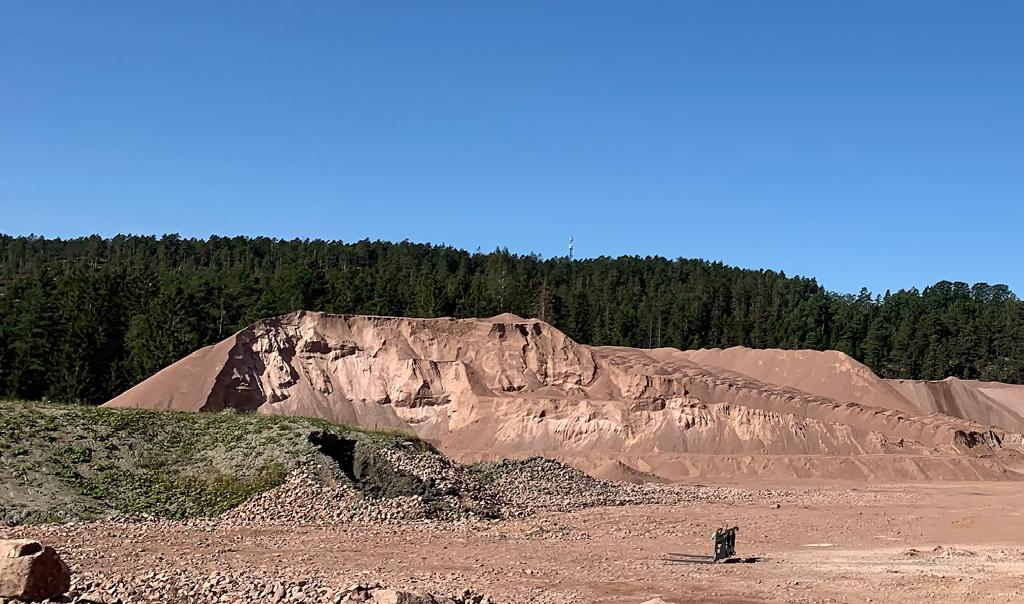
6
disciplines from natural sciences to The centre has established an outresearch cluster building on an interthe internationalization of the Northe goals is to ensure researcher knowledge and technology in areas future value creation. This is achieved between the stakeholders and rework is centred around many topics.To ensure a higher degree of disciplinary work packages: WP1 Sustainable reuse; 3 Regulatory frametopics and cases.
up in 2022. We have carried out from one of the largest harbours sediment fractions towards potenbeen started. A pilot for testing has been established and water, can be monitored online. Develop-

ment of methods for evaluating nature in life cycle analysis has started up. Our enthusiastic stakeholders are promoting stronger interaction between their new and ongoing projects and earthresQue research and innovation in focus groups. Our researchers and user partners are presenting their work through extensive outreach and dissemination on both national and international arenas.
The case studies have been defined in close collaboration with 24 user partners addressing the following research questions: How can new treatment processes for earth material wastes be developed to make these suitable as raw materials in new products? How can waste materials be managed in a sustainable manner, including all aspects of environmental, social and economic aspects? Including the management of old and future landfills. How can current obstacles for reuse be removed both in economic, regulatory, and governance terms? This includes business concepts to encompass society’s need for more reuse and recycling, and less use of virgin earth materials.
7

8
Vision and objectives
The primary objective is to develop technologies, systems, innovation, and a governance framework for the most sustainable management and treatment of wastes and earth materials, building on science-based education and information.
Secondary objectives are to ensure
• Recycling and reuse through new treatment processes for contaminated soils, surplus massed, C&D wastes, making them suitable as raw materials in new products. Including management of old landfill sites and sustainable solutions for future landfills.
• Sustainable management, re-use, and recycling of waste materials by developing methodologies and models to assess and document sustainability, including all aspects of environmental, social and economic aspects of recycled materials and treatment methods, based on internationally accepted standards.
• Regulatory framework and governance methodology to remove current obstacles, both in economic, regulatory, and governance terms. This includes optimised material flow and business concepts to encompass society’s need for more re-use/recycling and less use of virgin earth materials.
9
The ambition of the Centre is to become the nationally leading and internationally renowned research and innovation centre for sustainable use of waste earth materials
Research plan and strategy
Our strategy is to focus on the most relevant needs for research and innovation through close communication with the user partners. Research activities are centred around case studies, either a geographic location or a common challenge (e.g. specific contaminant). User partners have been strongly involved in defining obstacles for sustainable handling of surplus masses and knowledge gaps. Research and ongoing projects/activities among the user and research partners are intertwined. Student activities and educational programs at NMBU and BI are strongly incorporated into the case studies.
Key waste fractions and ‘rescue’ operations with innovation potential defined by the user partners
Dredged sediments: Norway has a long coast and there is a continuous need for dredging harbour areas. Dredged sediments usually contain pollutants and there is a need for improved methodology to separate contaminated from clean sediments. Potential for reuse in new products and or use for recreating wetland need documentation and innovative solutions.
Contaminated soils: Contaminated soils include soils from construction projects containing mineral and organic pollutants, press filter residue from soil washing facilities, PFAS contaminated soil. The objective of our work is to i) reduce transport (cost and distance)
ii) reduce costs for soil disposal and purchase of natural aggregates, iii) preserve landfill space, vi) conserve mined natural aggregate resources and reduce environmental and ecological impacts.
Tunnel boring machine material, TBM: These have mixed particle sizes and contamination potential is related to the host bedrock materials. earthresQue aims to recycle full-face tunnel boring machine masses from larger tunnelling projects.
Acid producing bedrock, these are a challenge in geologic regions with sulphide containing gneiss (Lillesand region) and black shale (Oslo region):The aim is to develop novel methods for testing and treatment to mitigate oxidation both on-site (road construction) in in-situ stabilization at landfills.
Construction & Demolition wastes
C&D wastes with focus in earthresQue are concrete and bricks. The objective is to develop technologies for recycling wastes from construction materials.
:
10
Lime-cement stabilized clays: Lime and cement are used to stabilize soft and quick clay in construction projects. The objective is to make way for new and better uses of this material.
Ashes from municipal solid waste incineration: have high pH and contain several unwanted trace elements, requiring safe handling and disposal. We aim to develop novel methods for utilising ashes as a secondary resource.
Old landfill masses: These usually contain mixed domestic and industrial wastes. High carbon content prevents re-landfilling. Treatment and handling solutions, tailored sustainability assessment tools and regulatory framework are required.
Landfill treatment: There is a need to develop safe storage and control of waste and water at landfills. Designs should isolate waste from the surrounding environment (atmosphere and water), they should also allow for potential use of the stored wastes by future technologies. Needs include improved methodology to delineate extent and contents of old landfills and develop methods to reclaim such areas, e.g.: remove contaminants, recycle materials, collect, and utilize or remove methane
releases. For both old and new landfills it is necessary to remove pollutants and risks associated with leachate, as well as reduce costs and prepare for aftercare.
Impermeable barriers: Four critical elements are required for a secure landfill: a bottom liner, a leachate collection system, a cover, and a suitable natural hydrogeologic setting. The natural setting should be selected to minimize the possibility of wastes contaminating groundwater and surface waters. earthresQue is developing methods for assessing hydraulic properties of fractured rock systems as a natural barrier. We are also testing the use of wastes, such as lime stabilized clays, as impermeable barriers.
Nature restauration: Conventional methods to evaluate nature through impact assessments and value-neutral surveys cannot quantify the impact of various measures, neither negative nor positive. Better tools for weighting and measuring natural diversity based on concretization and typification of nature are required. These will be tested on reclaimed contaminated areas and landfill sites.
11
Work with innovation in earthresQue
The Centre has good access to expertise on research and innovation both among user partners and research partners. Research and innovation work centred around the case structure, provides a strong link between the need for innovations, highlighted by the user partners, and the researchers. Different types of innovations are expected from the centre:
Substitution innovations: replacing existing methods and technologies with new technologies.
Efficiency innovations: improving technologies and methodologies to improve their results and outcome.
Market-creating innovations: The latter form embraces new configurations for value creation and forces all actors to approach value creating activities with different tools.
The Centre has taken steps to develop skills and stimulate cross-cutting innovation among the partners. To operationalize the new case structures, responsibilities and roles related to innovation is central. Two innovation workshops were organised by the Centre in 2022. In one workshop PhD fellows were challenged to define the impact and the potential for innovations based on their own work. Based on the Research Impact Canvas, they worked individually and in groups with guidance from internal and external resources. The research fellows were able to sharpen their message and the group gained a better understanding of each other’s work and possible synergies. Another workshop involved research and user partners to highlight innovation potentials in the centre and how these can be coordinated in the cases. The Centre will continue to organize seminars and workshops, geared to develop key innovation skills.
12

13
Photo: Showfabrikken/Kystverket
Organisation
Organisational structure
To ensure good progress and activity, the Centre organisation has been restructured from the original disciplinary Work Packages to an interdisciplinary case structure (figure 1). Each Case has a case leader (research partner) and a case promoter (user partner), thereby distributing responsibility and closed involvement of user partners.
The Faculty of Environmental Science and Natural Resource Management (MINA) at the Norwegian University of Life Sciences (NMBU) has the Centre administration and takes responsibility for the management and coordinates dissemination activities of the project and makes sure the work in the Centre is in accordance with the project plans approved by the research council and the board. The Centre management consists of the Centre manager, coordinator, and work package managers.

14
Figure 1: New organisational structure.
Centre Management
Centre Director, Professor at NMBU
Helen K. French
Deputy, Principal Engineer at NGI
Gudny Okkenhaug
WP leaders, Senior Researcher at NORSUS Ole Jørgen Hanssen and Associate Professor at BI Marit Sjøvaag
Centre Coordinator, Marte Norum
Guttulsrød and temp. Sindre Valvik
Innovation Advisor, Sjur Tveite
Centre Board
Magnus Sparrevik, Chair, Forsvarsbygg
Hans Fredrik Hoen, NMBU
Thomas J. Henriksen, AF Decom
Andreas O. Harstad, Skanska

Lise Reinertsen, Bergen municipality
Guro Grøneng, NGI
Hanne Lerche Raadal, NORSUS
Tormod Lundberg, Lindum
Ragnhild Kvålshaugen, BI
15
Our user partners range from municipalities and entrepreneurs to small start-up companies and business clusters, geographically distributed over all of Norway. They represent an enthusiastic group which combined with our scientific partners creates an inspiring working environment. Close collaboration between the different groups is a prerequisite for understanding the challenges of the industry and society which in turn nurtures creative research and innovation.

Collaboration between the Centre’s partners
There is close collaboration between user partners and research partners. In 2022, several meetings, seminars and workshops were organized on Teams and as physical meetings. The new organizational structure in cases and Topics constellated groups of interested partners, and a better platform for exchange of experience, information about new projects etc. In addition, workshops on cross cutting issues were organised, for example on public procurement and End-of-waste and requirements for characterization and documentation of treated masses. At the annual meeting, more than 60 researchers and user partners were gathered. Presentations and work in smaller groups were organised to plan activities for the coming period. We also organised a visit to Lindum (one of the partners) facility for sorting and treatment of waste to create new products, such as soil, compost and biochar. This is an important event for consolidating collaborating partners in the centre and exchange of ideas.
Partners
16
Research Institutes
BI – Norwegian Business School, IFE – Institute for Energy Technology, NGI – the Norwegian Geotechnical Institute, NORSUS – Norwegian Institute for Sustainability Research, NIBIO – Norwegian Institute of Bioeconomy Research, NILU – Norwegian Institute for Air Research, NIVA – Norwegian Institute for Water Research, and NMBU – Norwegian University of Life Sciences as Centre coordinator.
Private Sector
AF Decom, Borg havn, Borregaard, Eyde-klyngen, Frevar, Kronos Titan, Lindum, Iris, Innherred Renovasjon, NCCE, NOAH, Perpetuum, Scandi Energy, Skanska, Stena Recycling.

Public Sector
Bergen Municipality, Forsvarsbygg – The Norwegian Defence Estates Agency, Fredrikstad municipality, Kystverket -The Norwegian Coastal Administration (new partner in 2022), Lillestrøm municipality, Oslo municipality, Rogaland County, Skien municipality, Viken County, Ås municipality.
17
Photo: Showfabrikken/Kystverket
Scientific activities and results
Dredged sediments
Dredging of harbour sediments generates large amounts of surplus masses. Borg Havn, is one of the major harbours for shipping recycled waste in and out of Norway. It is situated at the outlet of Glomma, Norway’s largest river with a discharge of 1000 m3/sec and an annual sediment transport of 165 000 tonnes.
The dredged sediments are contaminated by harbour activities, but also contaminated sediments transported by Glomma from upstream activities. To reduce the amount of dredged sediments going to landfills (both terrestrial and marine), earthresQue has tested whether the contaminated and clean sediments can be separated. This was tested at AF Decom’s soil washing facility.
The aim is to recover clean sediments for recycling in new products or to rehabilitate wetlands. Both the planning and test phases have led to a change in the “mindset” of those involved (Main user partners: Borg Havn, Kystverket, AF Decom).
18
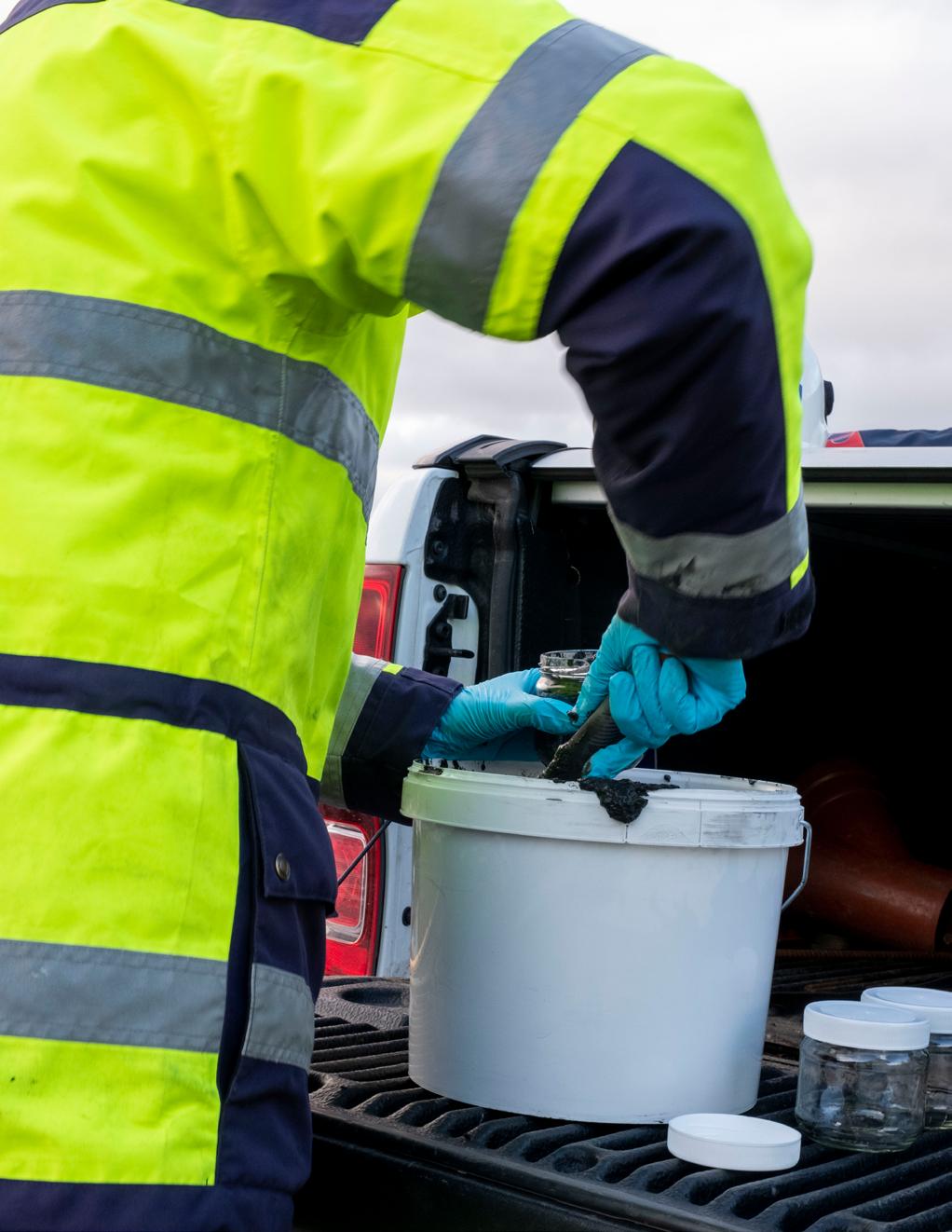
19
Photo: Showfabrikken/Kystverket
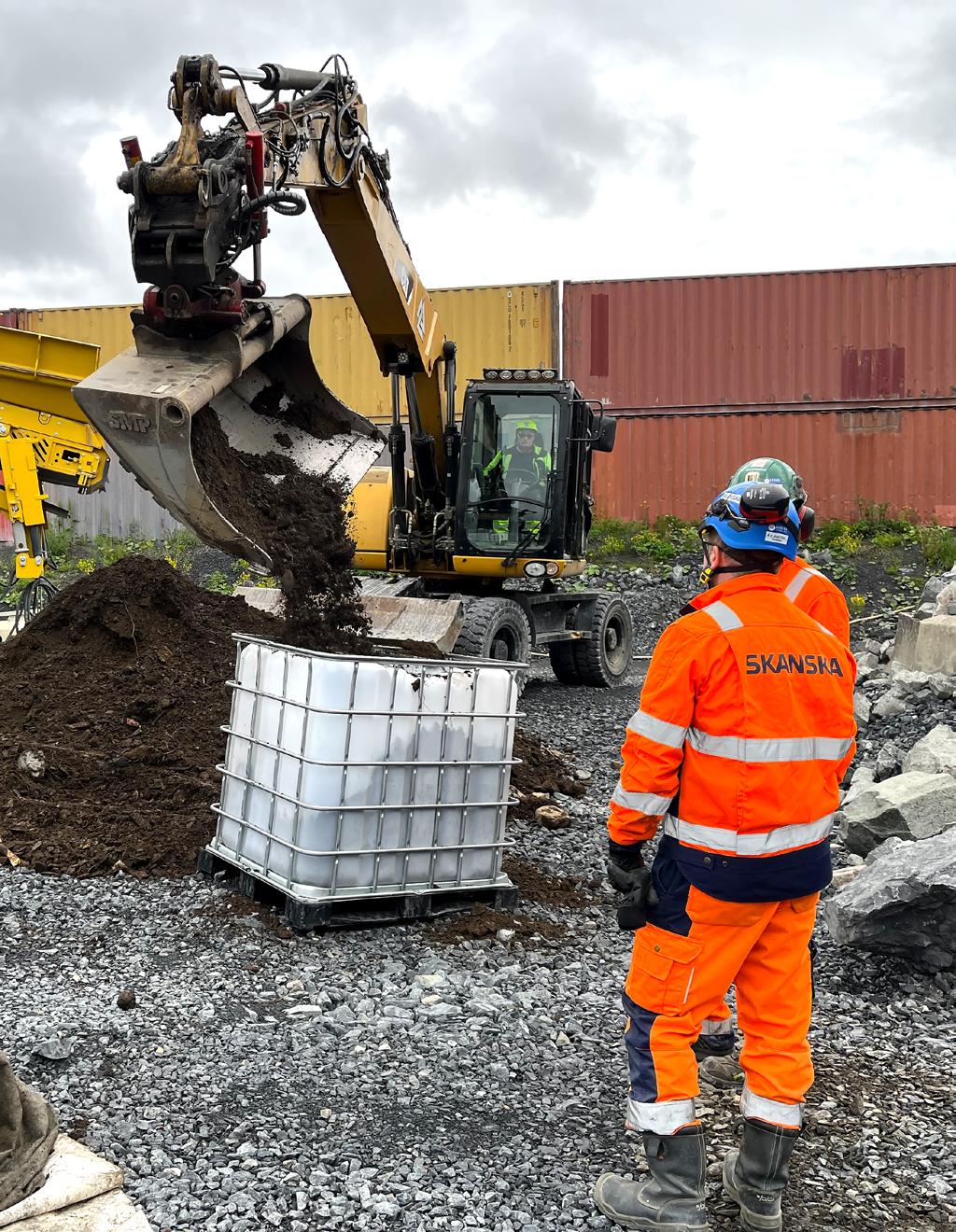
20
Contaminated soil
Contaminated soil is a common challenge in all construction projects in urban areas. In 2022, a pilot test was established with masses from E18, the main highway from Oslo to southern Norway. The aim is to document pollution risks linked to the recycled contaminated soil, treated by soil separation techniques.
Two master’s students have worked on aspects of moving contaminated soil. Life cycle analysis (LCA) was used to compare the environmental impact of soil washing at AF Decom’s facility with disposal at a landfill site. Another master’s student analysed how interaction and collaboration between stakeholders can be improved by using digital platforms. Several earthresQue partners are involved in testing such a platform. Some of the laboratory tests were carried out in collaboration with Geores, an EU project. (Main user partners: Skanska, AF Decom) (Bilder fra E18, Gudny/Andreas)
The ubiquitous Perfluorinated organic fluorine substances (PFAS) can cause great harm to health and the environment but are not removed by conventional soil treatment methods. A Master’s thesis documented that activated biochar from wood was the most effective sorbent (> 99% of the measured PFASs) out of seven waste-based sorbents. The tests were conducted on PFAS contaminated soil from a former fire training field. Based on this work, certain waste-based materials can have potential as economic and sustainable alternatives to commercial sorbents (Main user partners: Lindum, Forsvarsbygg, Perpetuum).
21
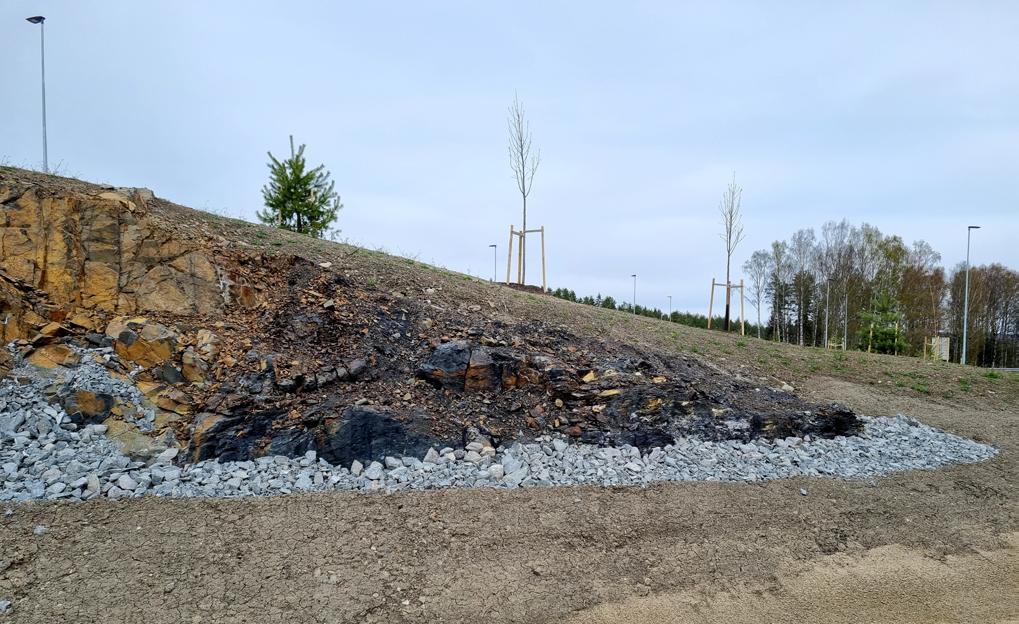
22
Acid producing rocks
Construction and excavation work in acid-draining rocks, such as black shale, produces large amounts of waste that requires stabilisation and landfilling to avoid acidic runoff and mobilization of metals such as uranium and cadmium.Thorough mapping during the planning phase combined with leachate testing and careful sorting during the excavation work on the road stretch EggemoenOlum on E16, provided useful information about extraction methodology for acid draining bedrock and led the way to innovative contractor’s project implementation. The results are reported in Tonje Strømø’s master’s thesis (Understanding environmental challenges during road construction in areas containing potentially acid producing black shale). Other experiments show reduced pollution from black shale when concrete is used to neutralize pH. These results provide basis for future design and methods for handling these type of wastes. (Main user partners: Skanska, NOAH, Lindum).
23
Construction and demolition wastes
One of the major challenges with the reuse of concrete waste is leaching of hexavalent chromium, Cr(VI), which is carcinogenic. Cathrine Eckbo, NGI, showed that leaching is reduced by 99% if the crushed concrete is mixed with soil with a high organic matter (25%). Finer crushing of concrete caused higher Cr(VI) concentration in the leachate, but age did not increase leaching from the concrete.The work in 2022 included container field tests to upscale laboratory scale Cr(VI) leachate. In addition, a master student established a laboratory column test on investigating the effect of using concrete as a neutralization agen for black shale. (Main user partner: NOAH, AF Decom).
24

25

26
Challenges with old landfills
Globally, thousands of closed landfills contain a mixture of domestic and industrial wastes with a high organic carbon content. Even tens of years after covering the landfills, the degradation of organic wastes cause release of methane and other gases into the atmosphere and contaminant leachate to the aquatic environment. Christian Schöpke (PhD fellow) has shown large variations in methane emissions at Brånåsdalen’s decommissioned landfill, which is one of earthresQue’s case study sites. His work is exploring how gas emissions are affected by atmospheric pressure water content, temperature, and carbon source. At the same site, a Master’s student used electrical resistivity tomography to map the horizontal and vertical extent of the waste.Though some consistency between low resistivity sections and locations of waste masses from a previous drilling campaign was found, the clearest boundary was found between the overlying masses and the bedrock. The similarity in electrical properties between the underlying clay and the wastes made it hard to distinguish between clay and waste. Next steps will involve time-lapse electrical resistivity measurements, combined with gas measurements. Analysis of natural isotope ratios in gas, waste and leachate will also be analysed in future sampling regimes (Main user partner: Lillestrøm kommune).
27
Creating impermeable barriers from wastes
Design of Landfill requires bottom, side and top barriers that prevent precipitation and groundwater to enter the landfill contents and also prevent internal drain water to leak to the surrounding environment. Constructed barriers for such purposes requires large quantities of appropriate material, such as dry crust clay. In earthresQue, alternative materials based on waste: press filter residue from AF Decom’s soil washing plant at Nes Miljøpark, and lime-cement stabilized clay, a typical surplus material from building and construction projects in areas prone to quick clay, have been tested and show promising results. A pilot to compare these materials has been established at NOAH, Langøya, and forms the basis for future design of landfill capping (Main user partners: NOAH, AF Decom).
28
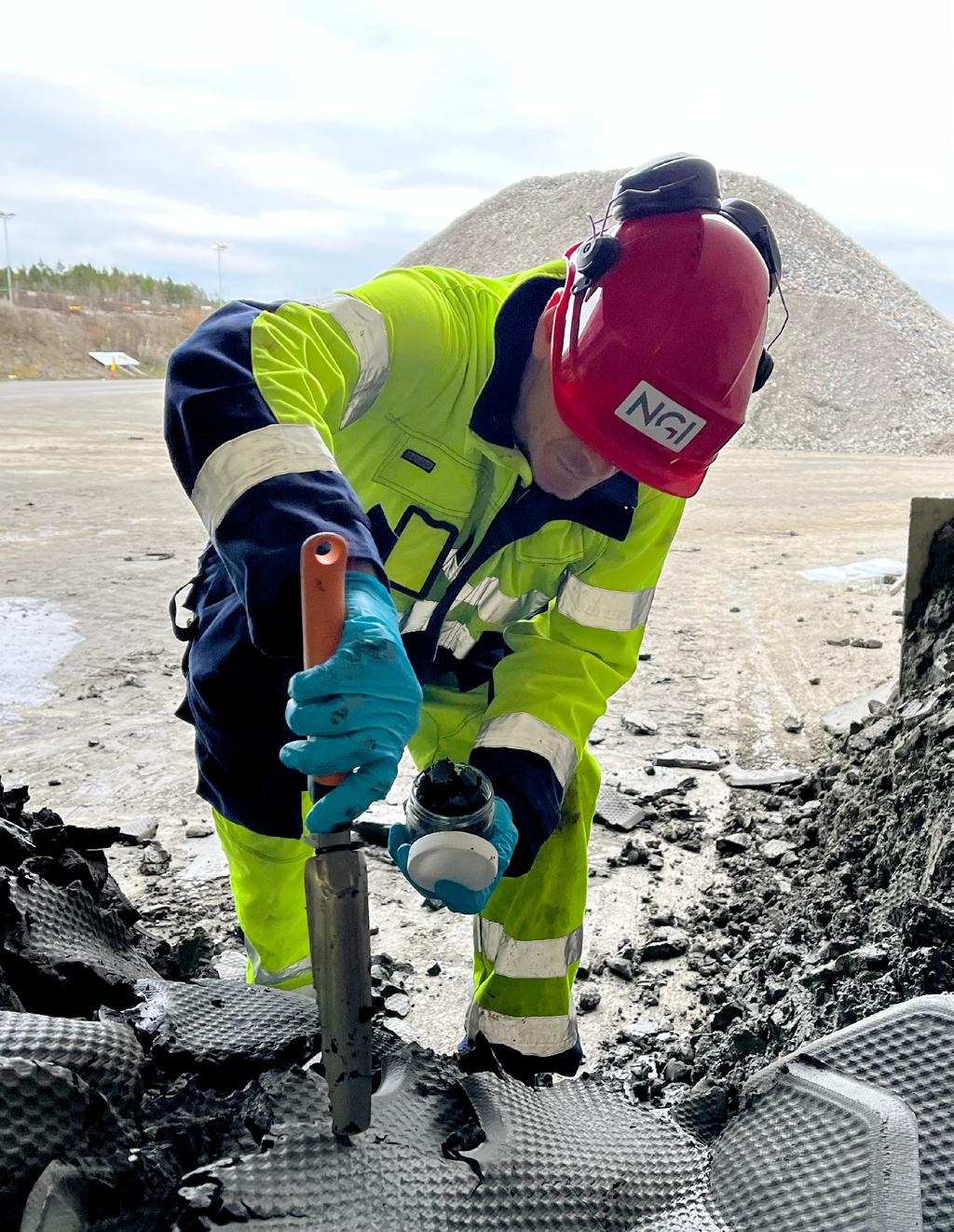
29

30
Photo: NMBU/ Håkon Sparre
International cooperation
Researchers in the centre collaborate with their respective international scientific networks, and we have dialogue with members of the Scientific advisory group about specific research activities in the centre. Contributions of our researchers to international courses, conferences and such, has led to proposals and planned collaboration activities for the coming years. Several guest researchers and students have visited or collaborated with earthresQue in 2022. Students or researchers came from Germany, France, the Netherlands and China, and their visits were funded by Marie Skłodowska-Curie Actions, earthresQue and national funding mechanisms.
earthresQue research partners have participated in EU proposal work lead by our international network, examples are UPGRADE, and the EU Soil Mission application ARAGORN. We have also participated in ongoing projects with a similar focus for example in RAWFILL: supporting a new circular economy for RAW materials recovered from landFILLs, and supplied contaminated shooting range peat soil to test cleaning technology (Envit, lead by University of Ljubljana).
31

32
Recruitment
PhD candidates financed by the Centre
Cathrine Eckbo
Ingvild Nygård
Bilal Tariq
Anders Gunnar Helle
Olav Bjerke Soldal
Jan Schneider
Associated PhD candidates
Karen Ane Skjennum, Lindum
Christian Schöpke, IFE
Simen Arne Kirkhorn, FFI
Einar Bratteng, NCCE partners

33
Communication and dissemination highlights
earthresQue hosted and co-hosted multiple seminars in collaboration with Avfall Norge (the Norwegian Waste Management and Recycling Association)
Landfill Seminar (Deponiseminaret): Top sealing of landfills; Construction Waste Conference (Byggavfallskonferansen); Arenadalsuka: Klimakampen i anlegg – Muligheter og barrierer (Skanska); GreenSmart, breakfast seminar (NMBU Sustainability arena)
Lectures in regular courses an NMBU
INN301 Innovation, MILJØ100 Introduction to Environmental Sciences, MILJØ302 Environmental Sciences, Forny302 Sustainable Management of Resources in a Circular Economy
International scientific conferences
Nordrocs, Joint European Stable Isotope User Group Meeting, Functional mAterials For energy, environment And biOmedical applicatioNs” (FARAON - 2022)
Communication to the general public
Web series «Forurenset grunn og svartskifer». Andreas O. Harstad from Skanska and Centre Director Helen K. French contributed to the production of”Veien til bærekraft - fra kunnskap til praksis” inn collaboration with NMBU and the Norwegian Public Roads Administration . Centre Director Helen K. French guested the Skift-podcast Science 4 Impact - Om forskningsdrevet innovasjon og en sirkulær avfallssektor.
A new teaching tool
The shift to circular economy and green solutions is complex and has many dilemmas. earthresQue has developed a teaching concept about this called “Bærekraftsrike”, in English it might be called the Kingdom of Sustainability. The aim is to provide experience and consciousness about the following: i) different aspects must be considered to solve environmental challenges, ii) different actors have different interests, viewpoints, desires and suggested solutions, but also speak different languages. The teaching concept has been tested on teachers training students, upper secondary pupils and BSc students at MINA.
34

35
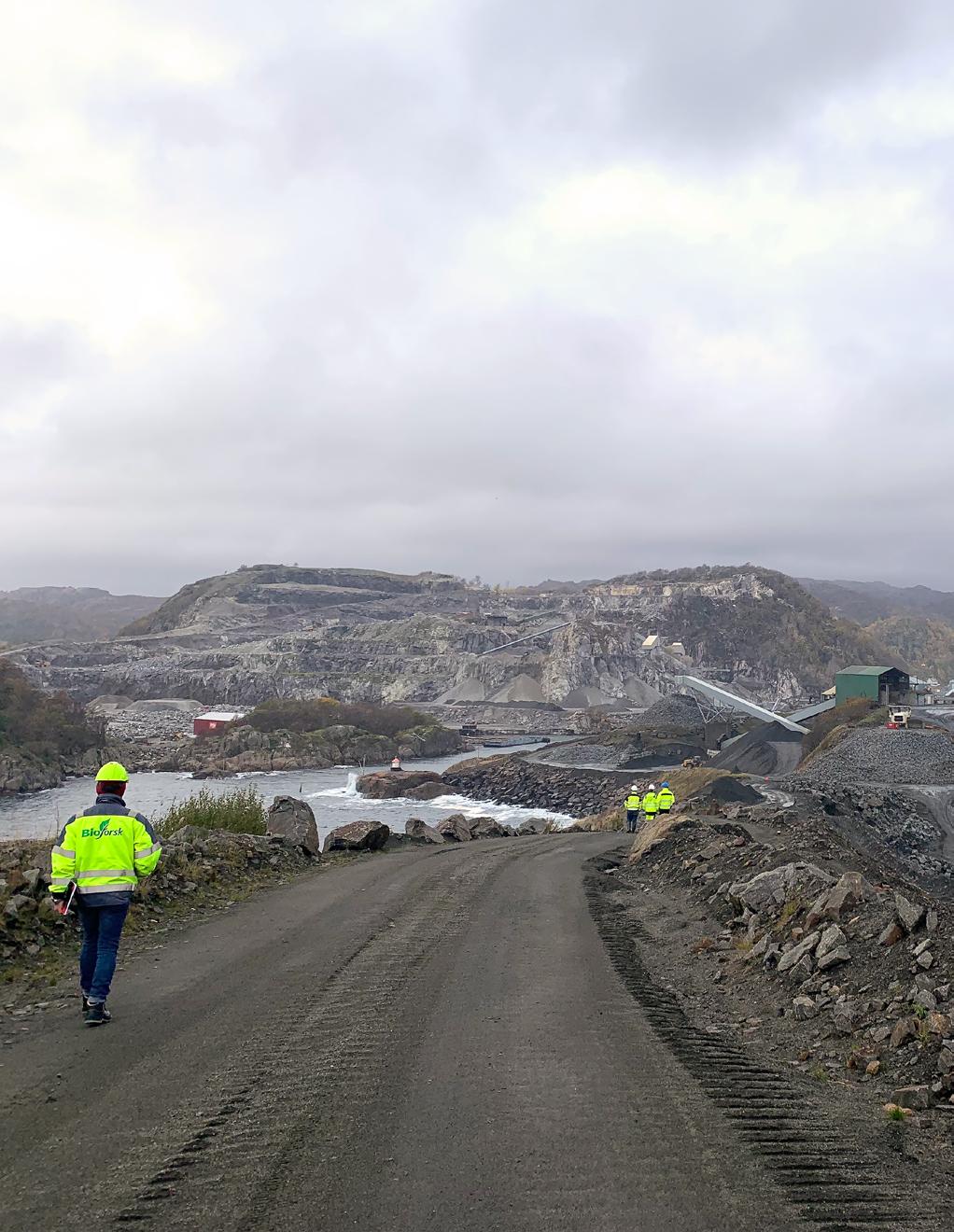
36

Funding The Research Council 11 247 Research partners 6 441 Private partners 6 386 Public partners 1 554 Total 25 628 Costs Research partners 17 688 Private partners 6 386 Public partners 1 554 Total 25 628 Numbers in 1000 NOK 37
Annual account 2022


























